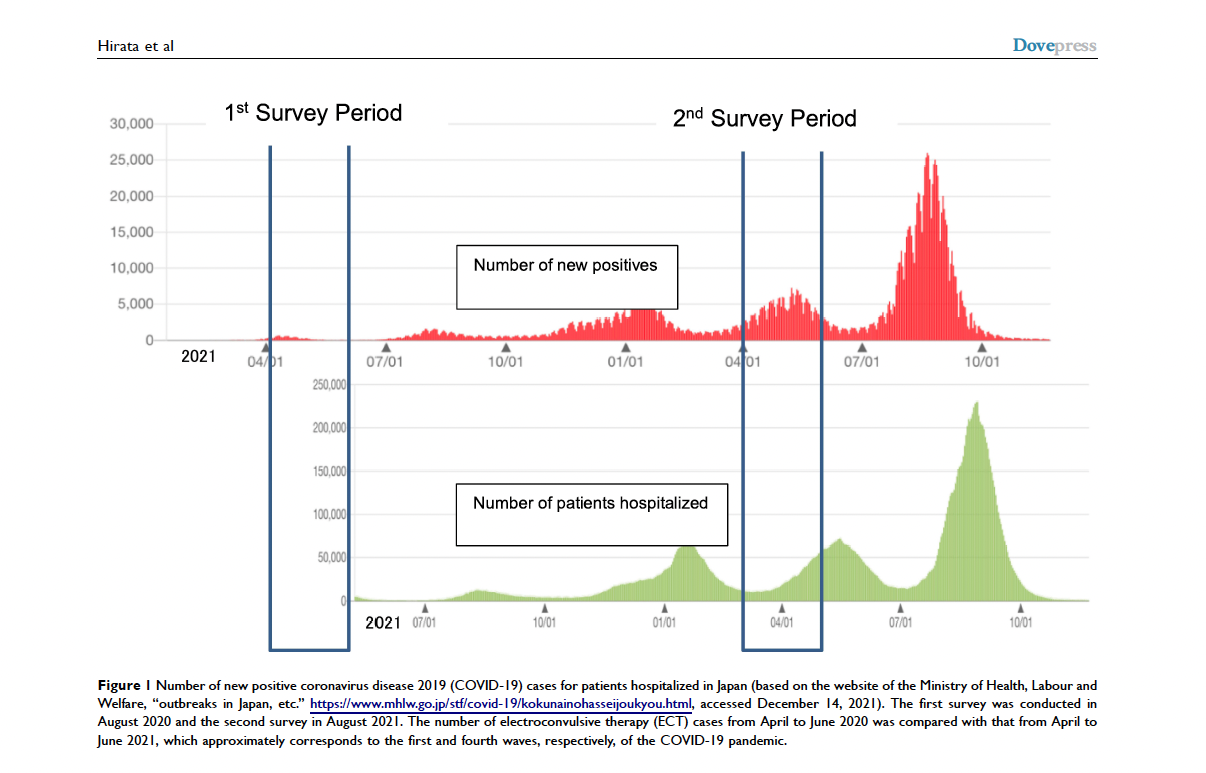ECT in Japan During COVID: New Survey Data
Out on PubMed, from researchers in Japan, is this paper:
An Online Survey About Electroconvulsive Therapy in Japan During the COVID-19 Pandemic: Comparison of Early and Recent Stages.
Purpose: To provide an overview of how electroconvulsive therapy (ECT) practice in Japan has changed as the coronavirus disease 2019 (COVID-19) pandemic continues.
Patients and methods: We surveyed healthcare institutions, primarily university and general hospitals, regarding changes in the number of patients undergoing ECT and infection control measures in the early (August 2020) and recent (August 2021) stages of the COVID-19 pandemic. Data for the early and recent stages were also compared between urban and non-urban areas.
Results: Among 32 facilities, the number of patients undergoing ECT decreased in 11 facilities (34.4%) from April 2020 to March 2021 compared with the previous year, whereas the number increased in 12 (37.5%) from April to June 2021 compared with the previous year. As of August 2021, some facilities had ongoing restrictions. Compared with non-urban facilities, the number of patients undergoing ECT decreased more in urban facilities, which also had more ECT restrictions. Maintenance ECT was used at the same rate as before the pandemic for 23 (82.1%) of 28 institutions. Regarding infection control measures, many facilities considered polymerase chain reaction testing before ECT and required all staff to wear surgical masks and eye shields during ECT.
Conclusion: The COVID-19 pandemic in Japan greatly affected the use of ECT in 2020; however, by the summer of 2021, infection control measures were relatively well established, the number of ECT cases stabilized and increased, and the decision to use ECT was again possible.
Keywords: clinical decision making; coronavirus disease 2019; electroconvulsive therapy; pandemic; personal protective equipment.
ECT is widely used in Japan as well as other countries, and the number of ECTs being administered is increasing,
with about 96,000 ECTs (0.76 per 1000 population) performed in 2019.11 The estimated number of ETCs performed in
Canada is approximately 67,000 (2.11–2.13 per 1000 population).
The number of ECT procedures was less affected in Japan than that in several other countries.3,4,14–16 According to
a previous paper from Canada, between mid-March and mid-May 2020, the number of ECT procedures in that country
decreased in 64% of facilities, with procedures completely stopped in 27% of facilities.3 In the United Kingdom and
Ireland in April 2020, 88% of facilities reported a decrease in the number of ECT procedures and 24% had stopped
completely, and in July 2020, 78% of facilities still reported a decrease in the number of procedures.4 The lower impact
of the pandemic on ECT practices in Japan may be due to the relatively small number of infected people and few
restrictions on movement in the society such as lockdowns. Each time that the COVID-19 infection spread, the Japanese
government introduced a state of emergency, but the stay-at-home guidelines were voluntary. Non-essential businesses
were asked to close, but rarely faced penalties for not complying.17
This is a very well presented paper with data about how ECT delivery in Japan was affected by the COVID pandemic. It reminds us that ECT is firmly established as part of psychiatric practice in Japan; the data on absolute number of ECT procedures (see above) are interesting. Maintenance ECT is also given a good amount of attention in this paper.
Kudos to these authors for this worthwhile contribution to the ECT service delivery literature.





Comments
Post a Comment